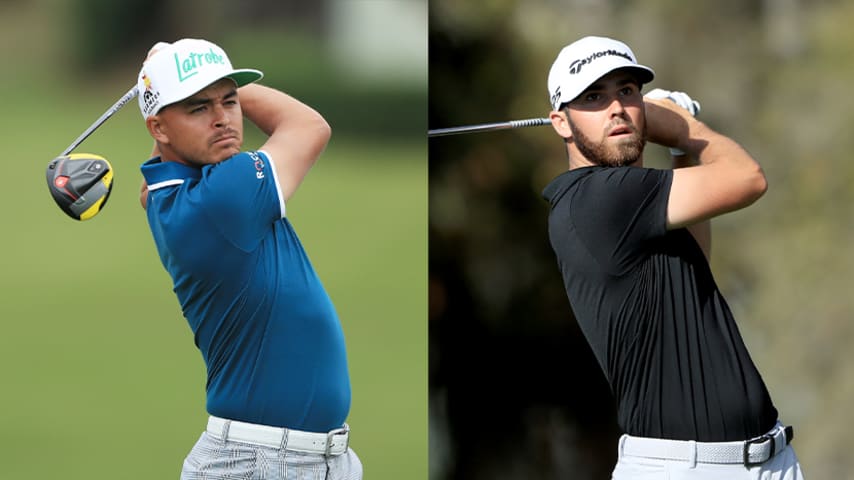From Southern California to Stillwater, Fowler and Wolff formed connection that will be on display at Seminole
4 Min Read

From Southern California to Stillwater, Fowler and Wolff formed connection that will be on display at Seminole
Rickie Fowler and Matthew Wolff highlights
Alan Bratton liked the low numbers.
Scores are usually the first data that coaches consult when seeking new recruits, but these were outliers that indicated Bratton was looking at special players.
Rickie Fowler was 15 years old and still wearing braces when he shot 62 to win Southern California’s high school championship in 2004. He was the first freshman since Tiger Woods to win that title.
RELATED:Fans at home will be able to contribute to TaylorMade Driving Relief’s COVID-19 relief efforts thanks to PGA TOUR Charities’ online and Text-To-Give donation platforms powered by GoFundMe Charity.Click here to donate.
This was an earlier time, though, before the widespread adoption of smartphones and social media, so it was still possible for such a sensation to stay a secret. Fowler hadn’t competed much outside California, so Bratton, then the assistant golf coach at Oklahoma State, thought he was ahead of the curve when he watched Fowler at the Western Junior. He kept his distance to avoid tipping off other coaches.
There was just one problem. Fowler won the tournament. With a final-round 64, including a birdie on 18, for a one-stroke win. The secret was out.
A few years later, Bratton heard about another special player going low. The tip came from a recruit who casually mentioned about playing a tournament where the winner shot 61 and won by 13. Bratton, who had become Oklahoma State’s head coach in 2013, needed to know the name of the kid who dusted the field by more than a dozen strokes.
It was Matthew Wolff.
While their stints in Stillwater, Oklahoma, were separated by a decade, ties run deep between Cowboys. Fowler returns to his alma mater often, playing golf with each member of the team and giving the players his phone number. Wolff’s team had dinner at Fowler’s house when they were in town for a tournament. Fowler was on hand to congratulate Wolff when he won.
So it made sense for Fowler and Wolff to be teammates when the TaylorMade Driving Relief match was in the works. They’ll need to tap into their penchant for shooting low scores if they want to succeed May 17 at Seminole Golf Club.
Their opponents in this four-ball skins game – Rory McIlroy and Dustin Johnson -- also have something in common. They’re the current and former World No. 1s.
“I’ve seen some fan reaction saying how much of a favorite Rory and DJ are, so Matt and I are going in as underdogs,” Fowler says. “We’re ready to bring the upset.”
Team chemistry could be an equalizer for the former Cowboys, though McIlroy revealed recently that he and Johnson had discussed teaming for this year’s Zurich Classic of New Orleans.
Fowler and Wolff met when Fowler returned to campus for homecoming. “We clicked right off the bat,” Wolff says.
For obvious reasons. Both developed unique swings while growing up on public golf courses in Southern California.
For Fowler, it was on the Murrieta Valley Golf Range, which co-owners Bill Teasdall and Barry McDonnell ran out of a single-story portable building on land that used to be a horse stable. McDonnell became Fowler’s first teacher. Wolff spent his formative years taking lessons from George Gankas at Westlake Golf Course, a 5,000-yard layout with artificial-turf mats on its driving range.
In junior golf, both players heard critics say they should change their unique swings. Neither heeded the advice. Bratton liked that each player developed his own swing and wasn’t afraid to stick to it, even in the face of criticism. He says he could recruit both players with his ears, not his eyes, because of the quality of the sound at impact.
“I love to look for natural swings,” Bratton says. “It doesn’t mean it has to be different, but I certainly want a kid who understands how to make adjustments on their own. You see a lot of kids who are trying to do something that someone else told them to do. There’s incredible instruction out there, but sometimes kids don’t understand or try to do something that’s not natural to them.”
Though Fowler can’t match Wolff’s swing speed, Bratton says there are similarities to their playing styles, as well.
“Once they make up their mind, they wind up and go,” says their former coach. “They look like they’re having fun when they play.”
Sean Martin manages PGATOUR.COM’s staff of writers as the Lead, Editorial. He covered all levels of competitive golf at Golfweek Magazine for seven years, including tournaments on four continents, before coming to the PGA TOUR in 2013. Follow Sean Martin on Twitter.
